There’s something heartwarming about boiled chestnuts, making them my favorite winter treat. They blend warmth, sweetness, and a touch of savory—all while packing a robust nutritional punch. And the best part? You don’t need an open fire, especially when a pressure cooker does the job efficiently.
Autumn’s embrace brings many joys, and fresh chestnuts top my list of reasons to eagerly anticipate October. Currently, I find myself back in Romania, my homeland, which is abundant with edible chestnuts. As a result, local farmers’ markets are brimming with these treats.
The nutritional punch of chestnuts
Unlike most nuts, chestnuts are carbohydrate-rich and low in fat. They boast a high fiber content and are abundant in minerals like manganese and potassium, as well as vitamins such as vitamin C and various B vitamins, including folate and copper (more details in the nutritional label provided below).
While I don’t typically count calories, for those curious, a serving of ten chestnuts approximates 200 calories. Perhaps it’s the wealth of potassium and other nutrients, but eating chestnuts leaves me feeling revitalized.
Their blend of warmth, sweetness, and nourishment makes them the ultimate comfort food, fitting perfectly with the demands of colder days. Isn’t it incredible how nature seems to know exactly what we need and when?
A Light-Hearted Aside: Not everyone shares my enthusiasm for chestnuts. My mother, for instance, likens their taste to sweetened boiled white potatoes—not the sweet potato variety, mind you, but your regular white potatoes with a sugary twist.

What does a chestnut look like?
Have you ever wondered about the appearance of an edible chestnut? It’s the fruit borne by the chestnut tree. Their sizes can vary, with the European variety showcased in the above picture being just one example.
At its core, the chestnut boasts a creamy white, edible flesh. Surrounding this flesh is a thin, light-brown layer—often referred to as the inner shell. Beyond this is a harder, glossy brown exterior commonly known as the outer skin, outer shell, or peel.
Distinctive to the chestnut, one end tapers to a point, adorned with a small tuft, while its opposite side resembles an eye, marked by a wood-like texture.
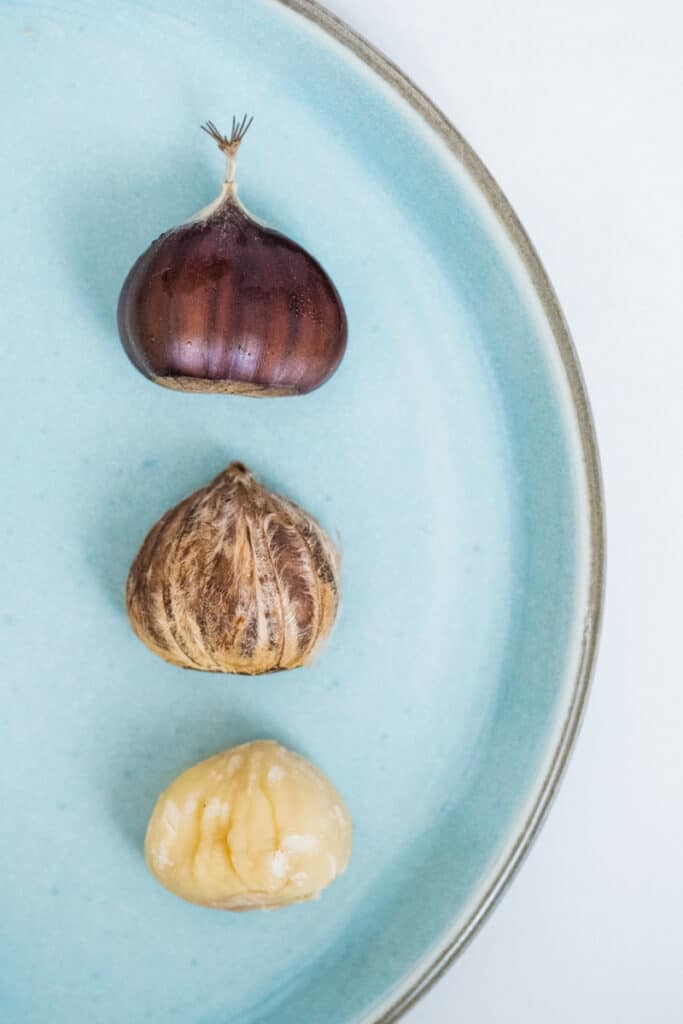
How to boil chestnuts
Boiled chestnuts are an absolute treat and my favorite way to cook chestnuts. While roasted chestnuts tend to have a drier texture, boiled chestnuts are soft and creamy.
Whether you’re using Spanish or European chestnuts like those commonly found in Romania or even American chestnuts, the boiling method remains pretty consistent. Although I haven’t tried the Asian variety, I expect the procedure to be similar.
Just keep in mind that American chestnuts tend to be bigger in size, so the boiling time might increase by a little bit.
Boiling chestnuts on the stove:
- Preparation: Before you begin, make sure the chestnuts are clean. While some people recommend scoring chestnuts (making small cuts on the chestnuts before boiling), I wouldn’t say I like this method. I prefer when the chestnuts are boiled whole, and no water gets into the white, edible flesh.
- Cooking: Place your chestnuts in a large pot of cold water, ensuring they’re fully submerged. Bring the water to a boil and let the chestnuts gently simmer for about an hour, or until they are tender. You can check doneness by taking one out and cutting it open. Be careful not to burn yourself. If the flesh is soft, they are done. This method requires patience but is the traditional way I grew up enjoying these delightful nuts.
Boiled chestnuts in a pressure cooker:
Last year, I discovered the magic of the pressure cooker for boiling chestnuts. Not only is it more efficient, but it also dramatically reduces the cooking time.
- Preparation: Ensure the chestnuts are clean.
- Cooking: Transfer the rinsed chestnuts to a pressure cooker or an Instant Pot. Cover them with cold water. Set the appliance on high pressure and cook for 7-9 minutes. After the cooking cycle completes, allow the pressure to release naturally. The result? Perfectly boiled chestnuts in a fraction of the traditional boiling time. For quantities and a detailed process, check out the recipe card at the end of this post.
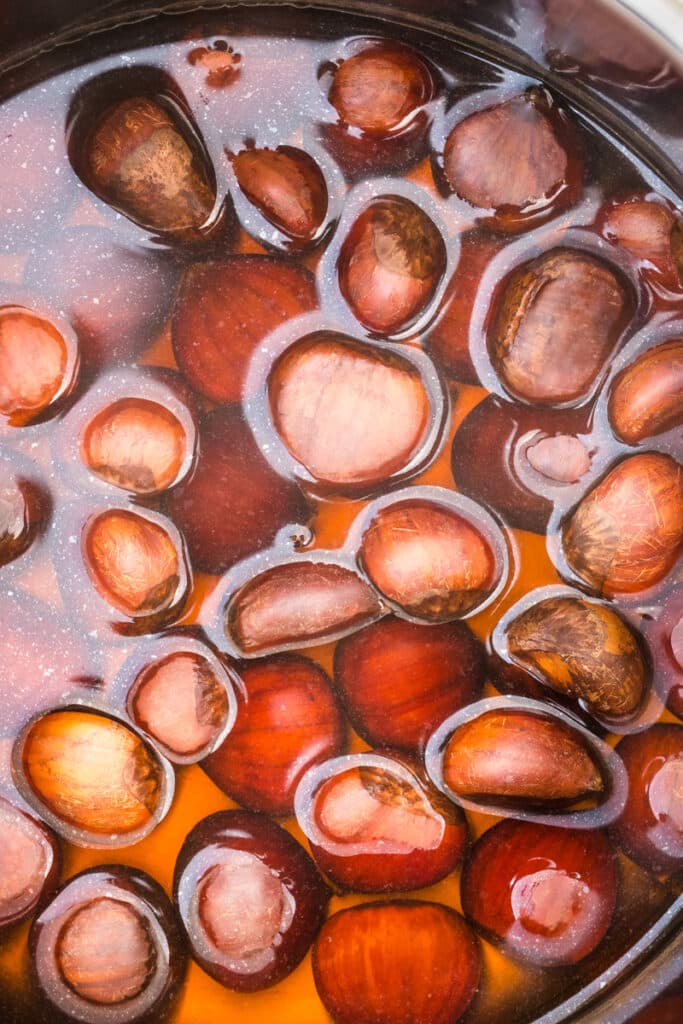
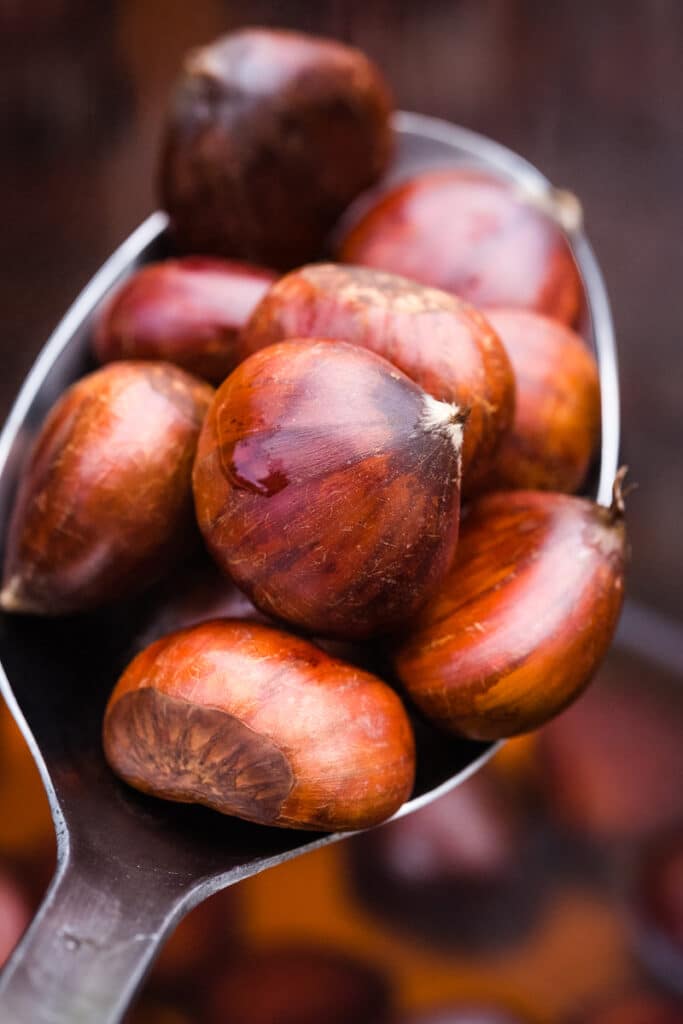
How to peel and enjoy chestnuts
For many, the art of peeling and relishing boiled chestnuts remains a mystery.
I still fondly recall the surprise on my friends’ faces in Dallas when I presented them with a bag of boiled chestnuts. They were baffled by this treat and had no clue how to approach it.
Peeling Boiled Chestnuts, The Rustic Approach: This method is perhaps the least polished but remains my preferred way. Holding the chestnut, I start by breaking the skin with my teeth at the tapered end, then proceed to scoop out the rich, creamy flesh. This technique might seem a bit ‘wild,’ but it’s straightforward and quick.
The Refined Method: For a more elegant presentation, especially in company, you can slice the chestnut with a small knife. Alternatively, use a paring knife to peel off the skins. There are even specially designed chestnut knives available on the market. These tools make the peeling process smoother, though using them proficiently may require a little practice.
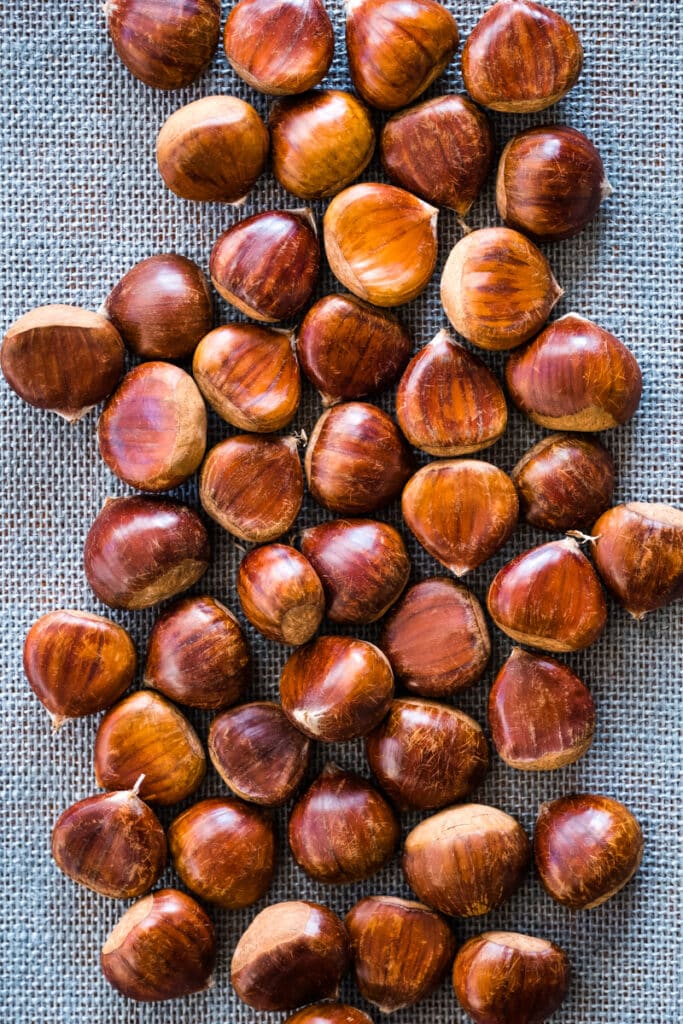
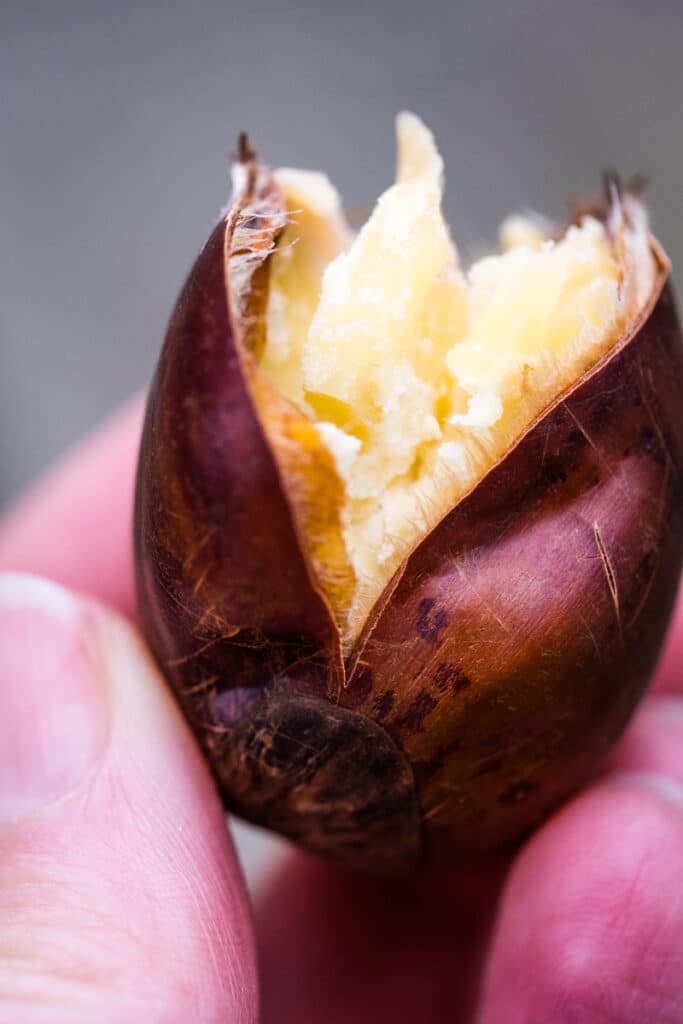
How to store boiled chestnuts
Leftover boiled chestnuts remain tasty the following day. Store them at room temperature, unpeeled, in a covered container.
If there are more leftovers after the second day, peel them, scoop out the white flesh, and use them for other dishes (see below a few ideas).
Incorporating boiled chestnuts into other dishes
While boiled chestnuts are delightful snacks in their own right, their culinary versatility shouldn’t be underestimated. Their unique texture and sweet and savory flavor can seamlessly enhance a variety of dishes.
For a savory treat, consider incorporating them into a Parsnip and Chestnut Puree with Chives.
Alternatively, use boiled chestnuts to make these decadent Chocolate and Chestnut Truffles.
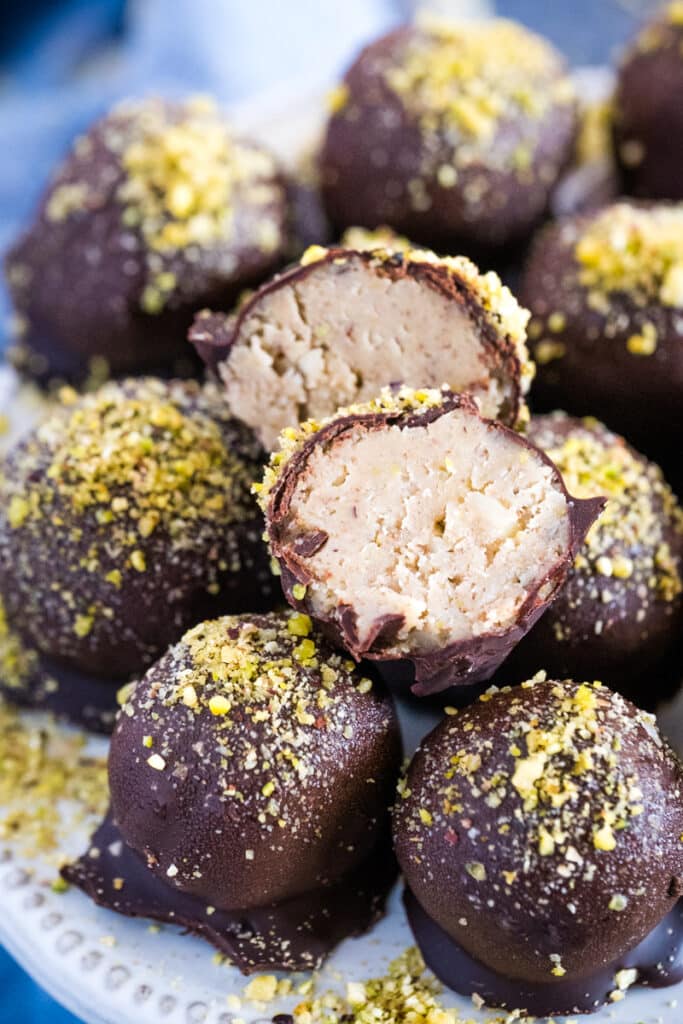
Canned or vacuum-packed chestnuts: a convenient alternative
For those who might not have the time or access to fresh chestnuts, there’s a convenient alternative available. Many grocery stores offer canned or vacuum-packed chestnuts that are pre-cooked and ready to use.
These preserved varieties can seamlessly substitute home-cooked chestnuts in various recipes. Whether you’re whipping up the Parsnip and Chestnut Puree or indulging in Chocolate Chestnut Truffles, these ready-to-use chestnuts ensure you don’t miss out on the unique flavor and texture they bring to the table.
Conclusion
Easy-to-prepare, boiled chestnuts are a nutritious and delicious, naturally gluten- and lectin-free snack. Leftovers can be incorporated into both sweet and savory dishes.
*This post contains affiliated links, which means I get a small commission if you choose to purchase something via one of my links, at no extra cost to you.
Print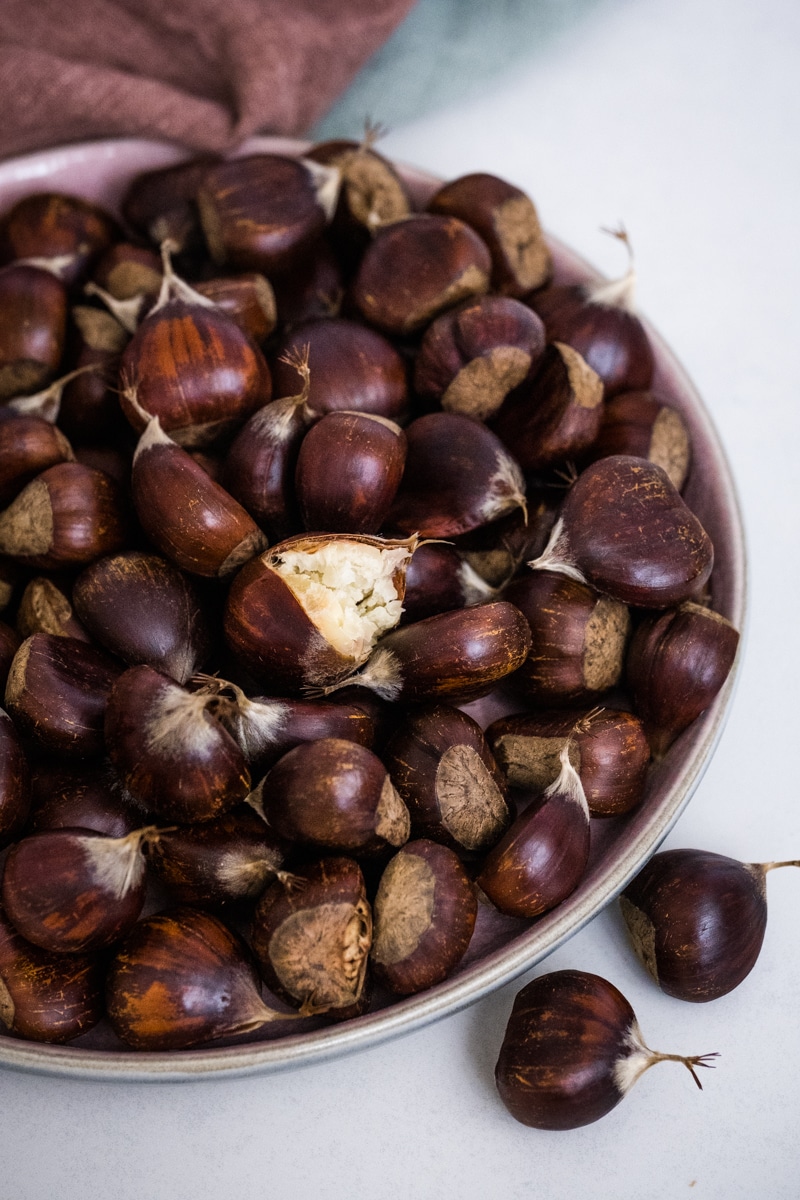
Boiled Chestnuts, the Perfect Snack (In a Pressure Cooker)
- Prep Time: 5 minutes
- Cook Time: 8 minutes
- Total Time: 13 minutes
- Yield: 8
Description
Warm, sweet, and nourishing, boiled chestnuts are the perfect winter snack. This is a quick method to prepare them, you won’t need an ‘open fire’.
Ingredients
- 1 kilogram / 2.2 lbs chestnuts
- enough water to cover them
Instructions
- Thoroughly rinse the chestnuts.
- Place them in your pressure cooker and add enough water to submerge them.
- Set the pressure cooker to high for 8 minutes. Allow the pressure to release naturally.
- Once the pressure is fully released, drain the chestnuts. They can be served either warm or cold.
- To consume, either slice the skin with a knife or break it using your teeth at the tapered end to access the creamy white flesh. For a cleaner result, use a paring knife to peel them.
- Leftover boiled chestnuts remain tasty the following day. Store them at room temperature, in a covered container.

No Comments